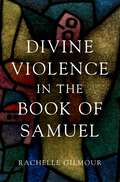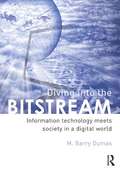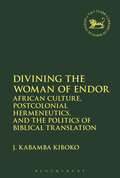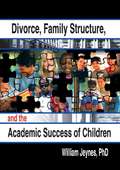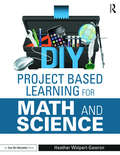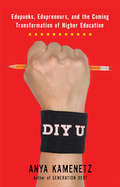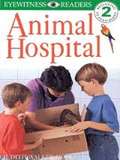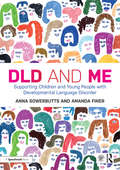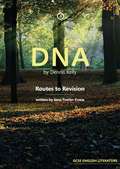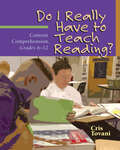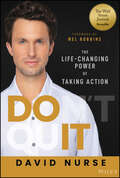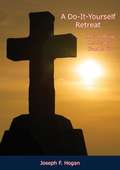- Table View
- List View
Divine Violence in the Book of Samuel
by Rachelle GilmourMuch of the drama, theological paradox, and interpretive interest in the Book of Samuel derives from instances of God's violence in the story. The beginnings of Israel's monarchy are interwoven with God's violent rejection of the houses of Eli and of Saul, deaths connected to the Ark of the Covenant, and the outworking of divine retribution after David's violent appropriation of Bathsheba as his wife. Whilst divine violence may act as a deterrent for violent transgression, it can also be used as a model or justification for human violence, whether in the early monarchic rule of Ancient Israel, or in crises of our contemporary age. In Divine Violence in the Book of Samuel, Rachelle Gilmour explores these narratives of divine violence from ethical, literary, and political perspectives, in dialogue with the thought of Immanuel Kant, Martha Nussbaum and Walter Benjamin. She addresses such questions as: Is the God of Samuel a capricious God with a troubling dark side? Is punishment for sin the only justifiable violence in these narratives? Why does God continue to punish those already declared forgiven? What is the role of God's emotions in acts of divine violence? In what political contexts might narratives of divine violence against God's own kings, and God's own people have arisen? The result is a fresh commentary on the dynamics of transgression, punishment, and their upheavals in the book of Samuel. Gilmour offers a sensitive portrayal of God's literary characterization, with a focus on divine emotion and its effects. By identifying possible political contexts in which the narratives arose, God's violence is further illumined through its relation to human violence, northern and southern monarchic ideology, and Judah's experience of the Babylonian exile.
Diving Into the Bitstream: Information Technology Meets Society in a Digital World
by Barry M. DumasNationwide, and indeed worldwide, there has been a growing awareness of the importance of access to information. Accordingly, information technology (IT), broadly defined and its role beyond the internal workings of businesses has leapt into the social consciousness. Diving into the Bitstream distinguishes itself by weaving together the concepts and conditions of IT. What distinguishes these trends is their focus on the impacts of IT on societies, and the responsibilities of IT’s creators and users. The author pulls together important, often complex issues in the relationships among information, information technologies, and societal constructs. The text explores a synopsis of these issues that are foundations for further consideration.
Diving Into the Bitstream: Information Technology Meets Society in a Digital World
by Barry M. DumasNationwide, and indeed worldwide, there has been a growing awareness of the importance of access to information. Accordingly, information technology (IT), broadly defined and its role beyond the internal workings of businesses has leapt into the social consciousness. Diving into the Bitstream distinguishes itself by weaving together the concepts and conditions of IT. What distinguishes these trends is their focus on the impacts of IT on societies, and the responsibilities of IT’s creators and users. The author pulls together important, often complex issues in the relationships among information, information technologies, and societal constructs. The text explores a synopsis of these issues that are foundations for further consideration.
Divining the Woman of Endor: African Culture, Postcolonial Hermeneutics, and the Politics of Biblical Translation (The Library of Hebrew Bible/Old Testament Studies #644)
by J. Kabamba KibokoAn examination of the language of divination in the Hebrew Bible, particularly in 1 Samuel 28:3-25-the oft-called “Witch of Endor” passage. Kiboko contends that much of the vocabulary of divination in this passage and beyond has been mistranslated in authorized English and other translations used in Africa and in scholarly writings. Kiboko argues that the woman of Endor is not a witch. The woman of Endor is, rather, a diviner, much like other ancient Near Eastern and modern African diviners. She resists an inner-biblical conquest theology and a monologic authoritarian view of divination to assist King Saul by various means, including invoking the spirit of a departed person, Samuel. Kiboko carries out a Hebrew word-study shaped by the theories of Mikhail M. Bakhtin regarding the utterance, heteroglossia, and dialogism in order to understand the designative, connotative, emotive, and associative meanings of the many divinatory terms in the Hebrew Bible. She then examines 1 Samuel 28 and a number of prior translations thereof, using the ideological framework of African-feminist-postcolonial biblical interpreters and translation theories to uncover the hidden ideology or transcript of these translations. Finally, using African contextual/cultural hermeneutics and cross-cultural translation theory, Kiboko offers new English, French, and Kisanga translations of this passage that are both faithful to the original text and more appropriate to an inculturated-liberation African Christian hermeneutic, theology, and praxis.
The Division Book: A Progression of Division Skills (PDF)
by Jillian CockingsPrimary school division book
Divorce, Family Structure, and the Academic Success of Children
by William JeynesTrace the influence of family factors on children's emotional and educational well-being!The effect of family changes on children's academic success is a new subject for study. Divorce, Family Structure, and the Academic Success of Children is a comprehensive volume that brings research on this hotly debated topic up to date. With clear tables and incisive arguments, it is a single-volume reference on this vexing sociocultural problem. Divorce, Family Structure, and the Academic Success of Children offers a close look at the historical background and current theory of this field of study. But it is more than a compendium of known facts and completed studies. It examines issues of appropriate methodology and points out concerns for planning future research. Divorce, Family Structure, and the Academic Success of Children summarizes current knowledge of the effects of various influences on children's emotional and educational well-being, including: divorce and remarriage single-parent families nontraditional family structures race socioeconomic status mobility Educators, theorists, sociologists, and psychologists will find this volume an essential resource. With hundreds of useful references and clear organization, it presents new ideas in an easy-to-use format that makes it an ideal textbook as well.
Divorce, Family Structure, and the Academic Success of Children
by William JeynesTrace the influence of family factors on children's emotional and educational well-being!The effect of family changes on children's academic success is a new subject for study. Divorce, Family Structure, and the Academic Success of Children is a comprehensive volume that brings research on this hotly debated topic up to date. With clear tables and incisive arguments, it is a single-volume reference on this vexing sociocultural problem. Divorce, Family Structure, and the Academic Success of Children offers a close look at the historical background and current theory of this field of study. But it is more than a compendium of known facts and completed studies. It examines issues of appropriate methodology and points out concerns for planning future research. Divorce, Family Structure, and the Academic Success of Children summarizes current knowledge of the effects of various influences on children's emotional and educational well-being, including: divorce and remarriage single-parent families nontraditional family structures race socioeconomic status mobility Educators, theorists, sociologists, and psychologists will find this volume an essential resource. With hundreds of useful references and clear organization, it presents new ideas in an easy-to-use format that makes it an ideal textbook as well.
DIY Programming and Book Displays: How to Stretch Your Programming without Stretching Your Budget and Staff
by Amanda Catherine Struckmeyer Svetha HetzlerThis manual guides librarians in creating simple, affordable, ready-to-use activities for children, 'tweens, teens, and families, with enough material for a full year of programs.Do-it-yourself programming is an emerging model in which the librarian does the preparation, then lets patrons take over. DIY Programming and Book Displays: How to Stretch Your Programming without Stretching Your Budget and Staff makes it easy for librarians to institute such programs in their own facilities.Organized around 12 thematic chapters, the book explains how to set up and maintain a do-it-yourself station and offers instructions for a variety of year activities. Reproducible materials and booklists are included as well. Librarians may use the activities as starting points for generating their own ideas or they may simply photocopy materials in the book for ready-to-use, monthly DIY programming. Once set up, the DYI station is available to patrons anytime they are in the library. Best of all, because DIY programs do not rely on staff, space, or special materials, they allow libraries to make the most of their resources without sacrificing patron service.
DIY Project Based Learning for ELA and History
by Heather Wolpert-GawronAre you interested in using Project Based Learning to revamp your lessons, but aren’t sure how to get started? In DIY Project Based Learning in ELA and History, award-winning teacher and Edutopia blogger Heather Wolpert-Gawron makes it fun and easy! Project Based Learning encourages students and teachers alike to abandon their dusty textbooks, and instead embrace a form of curriculum design focused on student engagement, innovation, and creative problem-solving. A leading name in this field, Heather Wolpert-Gawron shares some of her most popular units for ELA and Social Studies in this exciting new collection. This book is an essential resource for teachers looking to: Create their own Project Based Learning units. Engage student in their education by grounding lessons in real-world problems and encouraging them to develop creative solutions. Incorporate role-playing into everyday learning. Develop real-world lessons to get students to understand the life-long relevance of what they are learning. Assess multiple skills and subject areas in an integrated way. Collaborate with teachers across subject areas. Test authentic skills and set authentic goals for their students to grow as individuals. Part I of the book features six full units, complete with student samples, targeted rubrics, a checklist to keep students on track, and even "Homework Hints." Part II is a mix-and-match section of tools you can use to create your own PBL-aligned lessons. The tools are available as eResources on our website, http://www.routledge.com/books/details/9781138891623, so you can print and use them in your classroom immediately.
DIY Project Based Learning for ELA and History
by Heather Wolpert-GawronAre you interested in using Project Based Learning to revamp your lessons, but aren’t sure how to get started? In DIY Project Based Learning in ELA and History, award-winning teacher and Edutopia blogger Heather Wolpert-Gawron makes it fun and easy! Project Based Learning encourages students and teachers alike to abandon their dusty textbooks, and instead embrace a form of curriculum design focused on student engagement, innovation, and creative problem-solving. A leading name in this field, Heather Wolpert-Gawron shares some of her most popular units for ELA and Social Studies in this exciting new collection. This book is an essential resource for teachers looking to: Create their own Project Based Learning units. Engage student in their education by grounding lessons in real-world problems and encouraging them to develop creative solutions. Incorporate role-playing into everyday learning. Develop real-world lessons to get students to understand the life-long relevance of what they are learning. Assess multiple skills and subject areas in an integrated way. Collaborate with teachers across subject areas. Test authentic skills and set authentic goals for their students to grow as individuals. Part I of the book features six full units, complete with student samples, targeted rubrics, a checklist to keep students on track, and even "Homework Hints." Part II is a mix-and-match section of tools you can use to create your own PBL-aligned lessons. The tools are available as eResources on our website, http://www.routledge.com/books/details/9781138891623, so you can print and use them in your classroom immediately.
DIY Project Based Learning for Math and Science
by Heather Wolpert-GawronAre you interested in using Project Based Learning to revamp your lessons, but aren’t sure how to get started? In DIY Project Based Learning for Math and Science, award-winning teacher and Edutopia blogger Heather Wolpert-Gawron makes it fun and easy! Project Based Learning encourages students and teachers alike to abandon their dusty textbooks, and instead embrace a form of curriculum design focused on student engagement, innovation, and creative problem-solving. A leading name in this field, Heather Wolpert-Gawron shares some of her most popular units for Math and Science in this exciting new collection. This book is an essential resource for teachers looking to: Create their own project-based learning units. Engage student in their education by grounding lessons in real-world problems and encouraging them to develop creative solutions. Incorporate role-playing into everyday learning. Develop real-world lessons to get students to understand the life-long relevance of what they are learning. Assess multiple skills and subject areas in an integrated way. Collaborate with teachers across subject areas. Test authentic skills and set authentic goals for their students to grow as individuals. Part I of the book features five full units, complete with student samples, targeted rubrics, a checklist to keep students on track, and even "Homework Hints." Part II is a mix-and-match section of tools you can use to create your own PBL-aligned lessons. The tools are available as eResources on our website, www.routledge.com/9781138891609, so you can print and use them in your classroom immediately.
DIY Project Based Learning for Math and Science
by Heather Wolpert-GawronAre you interested in using Project Based Learning to revamp your lessons, but aren’t sure how to get started? In DIY Project Based Learning for Math and Science, award-winning teacher and Edutopia blogger Heather Wolpert-Gawron makes it fun and easy! Project Based Learning encourages students and teachers alike to abandon their dusty textbooks, and instead embrace a form of curriculum design focused on student engagement, innovation, and creative problem-solving. A leading name in this field, Heather Wolpert-Gawron shares some of her most popular units for Math and Science in this exciting new collection. This book is an essential resource for teachers looking to: Create their own project-based learning units. Engage student in their education by grounding lessons in real-world problems and encouraging them to develop creative solutions. Incorporate role-playing into everyday learning. Develop real-world lessons to get students to understand the life-long relevance of what they are learning. Assess multiple skills and subject areas in an integrated way. Collaborate with teachers across subject areas. Test authentic skills and set authentic goals for their students to grow as individuals. Part I of the book features five full units, complete with student samples, targeted rubrics, a checklist to keep students on track, and even "Homework Hints." Part II is a mix-and-match section of tools you can use to create your own PBL-aligned lessons. The tools are available as eResources on our website, www.routledge.com/9781138891609, so you can print and use them in your classroom immediately.
DIY U: Edupunks, Edupreneurs, and the Coming Transformation of Higher Education
by Anya KamenetzThe price of college tuition has increased more than any other major good or service for the last twenty years. Nine out of ten American high school seniors aspire to go to college, yet the United States has fallen from world leader to only the tenth most educated nation. Almost half of college students don't graduate; those who do have unprecedented levels of federal and private student loan debt, which constitutes a credit bubble similar to the mortgage crisis. The system particularly fails the first-generation, the low-income, and students of color who predominate in coming generations. What we need to know is changing more quickly than ever, and a rising tide of information threatens to swamp knowledge and wisdom. America cannot regain its economic and cultural leadership with an increasingly ignorant population. Our choice is clear: Radically change the way higher education is delivered, or resign ourselves to never having enough of it. The roots of the words "university" and "college" both mean community. In the age of constant connectedness and social media, it's time for the monolithic, millennium-old, ivy-covered walls to undergo a phase change into something much lighter, more permeable, and fluid. The future lies in personal learning networks and paths, learning that blends experiential and digital approaches, and free and open-source educational models. Increasingly, you will decide what, when, where, and with whom you want to learn, and you will learn by doing. The university is the cathedral of modernity and rationality, and with our whole civilization in crisis, we are poised on the brink of Reformation.
DIY Watercolor Christmas: Easy painting ideas and techniques for cards, gifts and décor
by Ingrid SanchezMake this Christmas a watercolor wonderland with this creative guide to painting through the festive season. Christmas is the perfect time to get creative with watercolors with lots of handmade cards to paint - but cards are only a small part of the ideas that you will get from this book. Here you'll find a wealth of inspiration and techniques for all sorts of watercolor projects this Christmas! First, the book covers the materials and equipment you need for watercolor painting – from paints and brushes to paper and other materials such as masking fluid and watercolor ground. You'll then learn how to create both traditional and contemporary color palettes for Christmas, and discover a wide range of watercolor techniques including washes, layering, blending and gradation, plus experimental ideas to try such as using salt, bleach and masking fluid in your work. Twelve creative projects follow, with easy-to-follow step-by-step tutorials so that even beginners to watercolor can jump right in. Learn how to paint your own Christmas cards, gift tags and gift boxes, create seasonal table settings, hand painted Christmas crackers and garlands, and unique hand-painted Christmas gifts including a watercolor wreath. Using innovative but accessible watercolor primer products, you can now prepare a wide variety of surfaces for watercolor painting. This inspirational book will also show you how to use these exciting new products to paint onto glass baubles, 3D cardboard letters, wooden tree ornaments and more. And once you have the skills, who knows where your imagination will take you? Finally, a gallery of additional Christmas motifs and designs that can be used for further inspiration can be found at the end of the book including reindeer, robins, mittens, snowflakes, stars, baubles, snowmen, candy canes, winter foliage, presents, decorations, elves and much much more! Artist Ingrid Sanchez, aka @creativeingrid, is a self-confessed Christmas afficianado who has brought all her Christmas spirit to bear in creating and illustrating this book. In this unique celebration of Christmas in watercolor, she shares her beautiful artwork and expert guidance, which will help you turn Christmas into the most artistic time of the year!
DK Readers, Level 2: Animal Hospital (PDF)
by Judith Walker-HodgeWhen Jack and Luke take an injured duck to the vet it is just the beginning of their adventures at the animal hospital. Stunning DK photographs combine with lively illustrations and engaging age-appropriate stories in Eyewitness Readers a multi-level reading programme guaranteed to capture children's interest while developing their reading skills and general knowledge.
DK Readers, Level 2: Animal Hospital (PDF)
by Judith Walker-HodgeWhen Jack and Luke take an injured duck to the vet it is just the beginning of their adventures at the animal hospital. Stunning DK photographs combine with lively illustrations and engaging age-appropriate stories in Eyewitness Readers a multi-level reading programme guaranteed to capture children's interest while developing their reading skills and general knowledge.
DLD and Me: Supporting Children and Young People with Developmental Language Disorder
by Anna Sowerbutts Amanda FinerDespite an increasing awareness of Developmental Language Disorder, there are very few tools available to help people understand and live with a diagnosis of DLD. DLD and Me is a functional, engaging resource for children and young people with DLD and the professionals and families that work with them. The book consists of an easy-to-follow, 12-week programme designed to help children and young people understand their strengths, what makes them different, what DLD is and how they can support their own communication in everyday life. Key features include: clearly worded session plans for therapists or education staff to follow; engaging visual resources to accompany the session plans, each available to photocopy and download; home sheets to keep families involved and informed; information sheets and training plans for parents and education staff; outcome measures to evaluate progress. This invaluable tool has been designed to be used by Speech and Language Therapists, teachers and other professionals or parents working with children and young people with DLD.
DNA by Dennis Kelly: Routes to Revision (Oberon Books)
by Iona Towler-EvansThis book provides a number of attractive and purposeful tasks and activities which engage students in active revision processes for the play DNA by Dennis Kelly, in order to help them to achieve specified AQA outcomes. It will incorporate creative and reflective tasks and devices, to help them make sense of the play for themselves, offer a personal and original response to the play in order to fulfil the requirements of the highest grades in GCSE English Literature.The main objectives of the book are as follows:- To offer attractive ways for the students to examine the text from a range of viewpoints.- To guide their thinking about the text, and provide the tools for analyses in terms of plot, settings, character, key themes and issues, language, structure, context.- To help students to relate the outcomes of tasks to the requirements of the most challenging examination questions.
Do Good Well: Your Guide to Leadership, Action, and Social Innovation
by Nina Vasan Jennifer PrzybyloWritten with a fresh voice and a dash of humor, Do Good Well is an exciting and readily adaptable guide to social innovation that not only captures the entrepreneurial and creative spirit of our time, but also harnesses the insights, wisdom, and down-to-earth experience of today’s most accomplished young leaders. Do Good Well offers a winning combination of theory, anecdote, and application, giving you the framework you need to make an impact next door or across the world. The authors present a 12-step process that empowers readers to act on their passions and concerns. This process is organized into three parts: Do What Works, Work Together, and Make It Last. They offer specific guidance for following the process through practical and prescriptive actions such building organizations, joining boards, applying for funding, creating partnerships with organizations that have similar goals, organizing conferences, and publicizing events. The book incorporates accounts of young people in action, and always reinforces the message that social innovation can be a lifestyle, made up of efforts small and large. It is not an all-or nothing proposition, and anyone can affect social change.
Do Good Well: Your Guide to Leadership, Action, and Social Innovation
by Nina Vasan Jennifer PrzybyloWritten with a fresh voice and a dash of humor, Do Good Well is an exciting and readily adaptable guide to social innovation that not only captures the entrepreneurial and creative spirit of our time, but also harnesses the insights, wisdom, and down-to-earth experience of today’s most accomplished young leaders. Do Good Well offers a winning combination of theory, anecdote, and application, giving you the framework you need to make an impact next door or across the world. The authors present a 12-step process that empowers readers to act on their passions and concerns. This process is organized into three parts: Do What Works, Work Together, and Make It Last. They offer specific guidance for following the process through practical and prescriptive actions such building organizations, joining boards, applying for funding, creating partnerships with organizations that have similar goals, organizing conferences, and publicizing events. The book incorporates accounts of young people in action, and always reinforces the message that social innovation can be a lifestyle, made up of efforts small and large. It is not an all-or nothing proposition, and anyone can affect social change.
Do I Really Have to Teach Reading?: Content Comprehension, Grades 6-12
by Cris TovaniDo I really have to teach reading? This is a question many teachers ask, wondering how they can add a new element to an overloaded curriculum. The answer is yes; if teachers want their students to learn complex new concepts in different disciplines, they need to help develop their students&’ reading skills.In Do I Really Have to Teach Reading?: Content Comprehension, Grades 6-12 , author Cris Tovani takes on the challenge of helping students apply reading comprehension strategies in any subject. Tovani shows how teachers can expand on their content expertise to provide the instruction students need to understand specific technical and narrative texts. Inside the book you&’ll find: Examples of how teachers can model their reading process for students Ideas for supplementing and enhancing the use of required textbooks Detailed descriptions of specific strategies taught in context Stories from different high school classrooms to show how reading instruction varies according to content Samples of student work, including both struggling readers and college-bound seniors Comprehension Constructors : guides designed to help students recognize and capture their thinking in writing while reading Guidance on assessing students Tips for balancing content and reading instruction Tovani&’s humor, honesty, and willingness to share her own struggles as a teacher make this a unique take on content reading instruction that will be valuable to reading teachers as well as content specialists.
Do I Really Have to Teach Reading?: Content Comprehension, Grades 6-12
by Cris TovaniDo I really have to teach reading? This is a question many teachers ask, wondering how they can add a new element to an overloaded curriculum. The answer is yes; if teachers want their students to learn complex new concepts in different disciplines, they need to help develop their students&’ reading skills.In Do I Really Have to Teach Reading?: Content Comprehension, Grades 6-12 , author Cris Tovani takes on the challenge of helping students apply reading comprehension strategies in any subject. Tovani shows how teachers can expand on their content expertise to provide the instruction students need to understand specific technical and narrative texts. Inside the book you&’ll find: Examples of how teachers can model their reading process for students Ideas for supplementing and enhancing the use of required textbooks Detailed descriptions of specific strategies taught in context Stories from different high school classrooms to show how reading instruction varies according to content Samples of student work, including both struggling readers and college-bound seniors Comprehension Constructors : guides designed to help students recognize and capture their thinking in writing while reading Guidance on assessing students Tips for balancing content and reading instruction Tovani&’s humor, honesty, and willingness to share her own struggles as a teacher make this a unique take on content reading instruction that will be valuable to reading teachers as well as content specialists.
Do It: The Life-Changing Power of Taking Action
by David NurseDemolish roadblocks, take action, and transform your future No matter what is holding you back, Do It offers a proven solution to actualizing the life you long for. Author and renowned mindset specialist, David Nurse, reveals the nine reasons that you don’t take action, how to successfully overcome your personal roadblocks, and the secret to achieving remarkable results. The reason you aren’t accomplishing your dreams is not because you don’t want to; it’s because you don’t know how to. And the reason you don’t know how to is not because you aren’t capable or smart enough. It’s simply because you—and 99% of the population—have roadblocks you are completely unaware of. Before you can conquer the enemy, you must identify the enemy. Based on extensive research studies, the science of the heart and mind connection, and captivating examples throughout history, Do It reveals the enemy that is holding you back—what Nurse calls your “action archetype.” These arechetypes include The Allodaxophobic, The Burned, The Blamer, The Perfectionist, and more. Through the nine archetypes, you’ll learn profound lessons about yourself and you'll come away: A newfound awareness about what holds you back Powerful, actionable tools to propel you forward Stories of influential people who have overcome their own roadblocks to achieve extraordinary success Nurse’s revolutionary philosophy will completely reshape the way you think about failure and success and propel you to levels you didn't even imagine were possible—all through the life-changing habit of taking action.
Do It: The Life-Changing Power of Taking Action
by David NurseDemolish roadblocks, take action, and transform your future No matter what is holding you back, Do It offers a proven solution to actualizing the life you long for. Author and renowned mindset specialist, David Nurse, reveals the nine reasons that you don’t take action, how to successfully overcome your personal roadblocks, and the secret to achieving remarkable results. The reason you aren’t accomplishing your dreams is not because you don’t want to; it’s because you don’t know how to. And the reason you don’t know how to is not because you aren’t capable or smart enough. It’s simply because you—and 99% of the population—have roadblocks you are completely unaware of. Before you can conquer the enemy, you must identify the enemy. Based on extensive research studies, the science of the heart and mind connection, and captivating examples throughout history, Do It reveals the enemy that is holding you back—what Nurse calls your “action archetype.” These arechetypes include The Allodaxophobic, The Burned, The Blamer, The Perfectionist, and more. Through the nine archetypes, you’ll learn profound lessons about yourself and you'll come away: A newfound awareness about what holds you back Powerful, actionable tools to propel you forward Stories of influential people who have overcome their own roadblocks to achieve extraordinary success Nurse’s revolutionary philosophy will completely reshape the way you think about failure and success and propel you to levels you didn't even imagine were possible—all through the life-changing habit of taking action.
A Do-It-Yourself Retreat: How To Bring Out the Real Good In You
by Joseph HoganThe do-it-yourself appeal which is somewhat popular today is not just a fad. It meets the basic need in man to be creative.This DO-IT-YOURSELF RETREAT makes the same appeal to your highest creative instincts.However, in this case, you are shown not how to make some thing, but HOW TO BRING OUT THE REAL GOOD IN YOU and make yourself into the truly great person that God intended you to be. These pages will help you to discover who you really are, and the discovery will prove to be encouraging and consoling.Although you are doing-it-yourself, this retreat follows a time-tested and approved method. It is progressive. Step by step it helps you to bring out the potential for all the goodness and greatness which is present in you.You are also following a mystery story—these are God’s mysteries—so you do not peek at the chapters ahead. One step at a time is best, and God be with you on the way.This book is for...Those who have never made a retreat, and those to whom the word may sound strange or even forbidding. I think you will like it, and though you start it as an experiment, you may find it so interesting and worthwhile that you will want the fuller and richer experience at a retreat house.Those who would like to make a closed retreat but cannot, especially God’s beloved sick and suffering and those in the evening of life.Those who have made a retreat and who would like to retain the clarity of vision and the peace of soul it gave them.Husbands and wives who would like to make a retreat at home, either together or individually. It can help to oneness in outlook.Finally, but finally only for emphasis, this book is for students who are making an open retreat and want a companion book—collateral reading—to keep them in the spirit of the retreat.
